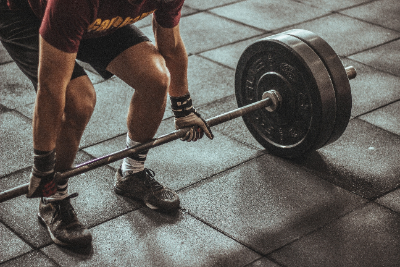Strength and conditioning advice for endurance athletes has come a long way over the years. And it's just as well, unless you really enjoy the idea of competing in the nude like the Ancient Greek athletes or deadlifting a male calf as part of your training regime, a la Milo of Croton in the 6th Century BC.
Many thousands of years of science, technology, experience, and a fair amount of trial and error, has led to a lot less cattle-lifting in your local gym (although a lot more selfie photos on Instagram). In turn, we continue to see human performance excel beyond what once was deemed impossible.
But when we strip it down, are enough endurance athletes using strength work to their advantage?
We take a look at how attitudes towards S&C for endurance performance have changed over the years and why there needs to be a greater focus on an individualised approach, rather than an 'off the shelf' program...
The ‘Old School’ approach
As recently as 10 years ago (and to some extent to this day) strength and conditioning for endurance performance has been perceived as being an elite behaviour, an ‘extra’ for those looking for that 1-2%.
Even now, we see some athletes who don't make time for S&C because it's not viewed as a necessity, or they worry that it will make them too bulky and slower, or even cause injury.

It's perhaps an understandable viewpoint as individuals who want to swim, run or ride for miles could be forgiven for wondering what value S&C has for them when they think much of the strength research has been based on sports like powerlifting. Significant amounts of funding, infrastructure and equipment for strength training has been targeted at the development of non-endurance based sports.
Add into that a lack of correct education within the coaching faculty, the benefits of developing the strength qualities within endurance athletes have often been overlooked and undervalued.
Looking back at the ways endurance athletes have implemented strength and conditioning into their schedules, there are some common training errors that we've seen:
- Limited to the off-season. Practised for only 1-2 months of the year, but expecting the benefits to last the whole year
- A focus on predominantly bodyweight exercises and band work, with some sporadic free weights integrated when possible
- Many individuals select versions of “strength training” that are in fact detrimental to their endurance performance - too much volume, intensity and not specific enough to the individual's needs. This can be seen in many group class environments, such as HIIT classes, circuits or body pump
- Very little prescription of the necessary progressive overload (i.e. endurance athletes simply aren’t lifting heavy enough to prepare their body for the demands of the sport)
- Thinking that big gear work, hill sessions or paddle work are sufficient alternatives to strength training in the gym
Being on the ground, amongst athletes training and talking to them at races and endurance exhibitions, it's been fascinating for us to hear stories of people struggling with ongoing injuries and frustrating performance plateaus over the years. And yet very few weren’t considering the most basic solution to their problems - simply making their bodies stronger.
‘Wising up’
In the last few years, awareness has been growing with many appreciating the benefits that strength and conditioning can have upon their endurance performance. This has been due to a number of factors, not least the publication of research highlighting the benefits of strength work for endurance athletes and strength training improving performance amongst cyclists, as well as:
- An increase in private training facilities
- Social media bridging the gap; providing inspiration, education and visual resources
- The ease to get hold of S&C programs via the internet
However, proper S&C is more than just prescribing strength exercises through Instagram or the internet. The problem is that people can get complacent and think that what they're being told to do by a standard guide is enough. Often, one look at what they're doing makes it clear that they're not considering all of the necessary principles of a successful program (i.e recovery, physiology, psychology, nutrition).
For example, consider these two workouts below:
Workout A
- 4 Rounds - (45 seconds of work - 15 seconds of rest)
- Complete as many reps as you like per exercise
Move from station to station, rest for 60 seconds at the end of each complete set of exercises:
- Goblet Squat
- Box Jump
- Knee Through
- Plank
- Lunge walk
- TRX Row
- KB Swing
Workout B
1a. Goblet Squat - 4 x 8 @ 16kg
1b. Box Jump - 4 x 5 @ 12 inch step
(Rest 60-90 seconds between supersets)
2a. TRX Row - 3 x 8
2b. KB Swing - 3 x 8 @ 16kg
(Rest 60-90 seconds between supersets)
- Lunge Walk - 3 x 16 (8 e/s) @ 8kg (Dumbbell each hand)
(Rest 60-90 seconds between supersets)
4a. Knee Through - 3 x 20 (10 e/s)
4b. Plank - 3 x 30 seconds hold
(Rest 60-90 seconds between supersets)
Both include the same exercises, but Workout A showcases more of an exercise routine. There's no clear way to track your progress week to week, no prescription of progressive overload (increasing reps and sets), no clear recovery times and little individualisation.
Even the Ancient Greeks had an idea of the importance of progressive overload in training, albeit lifting cows was perhaps taking personalisation a little too far!
Workout B lays out a logical order of exercises based upon the neurological load. The harder more complex exercises are at the beginning to maximise quality of technique, but also to ensure a lower level of risk.
There are clear levels of intensity and recovery times prescribed, allowing for optimal stimulus and adaptation during the workout. This formula can then be adapted week on week, manipulating the intensity simply by adjusting one of the variables (i.e. reps, sets, rest), which is more efficient and logical when looking to integrate into a busy endurance athlete's lifestyle.
So, the future is looking promising for strength and conditioning within the endurance population, but it may be a while yet before it becomes the norm. For the coaches and athletes who have a good understanding of the demands of their sport and how to integrate and periodise an S&C program without taking anything away from their endurance pursuits, they're the ones who are ahead of the game and will reap the benefits and see the results.
To understand how to apply and integrate strength and conditioning into a busy athlete's lifestyle, check out the Strength For Endurance Fundamentals Training Course.
